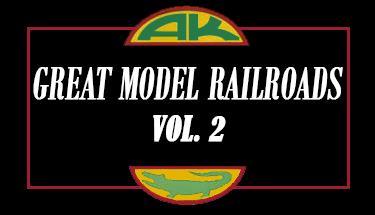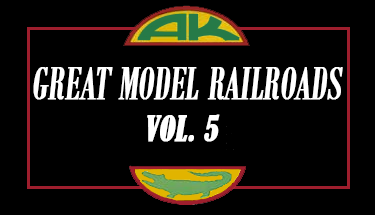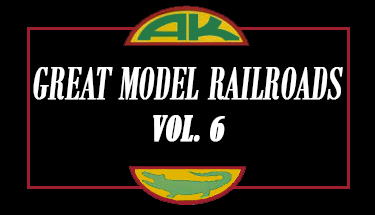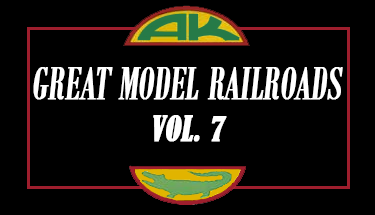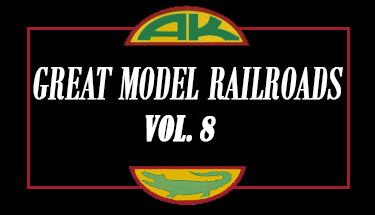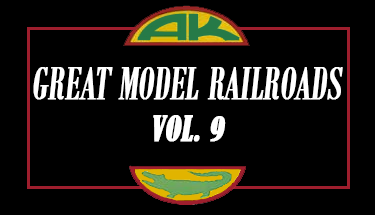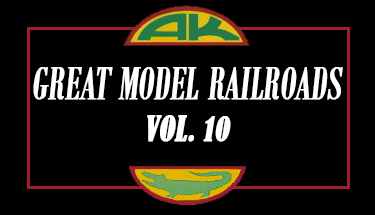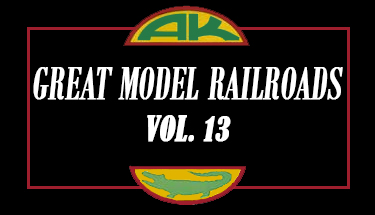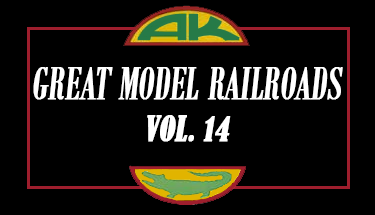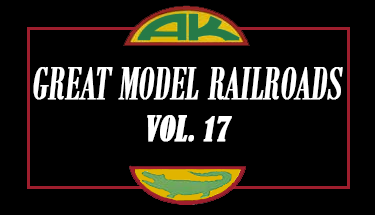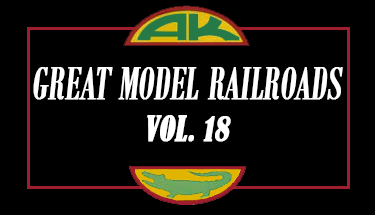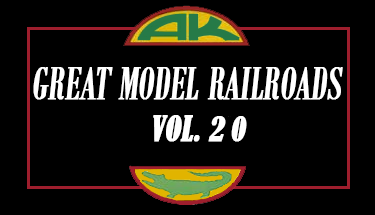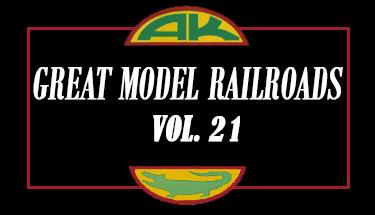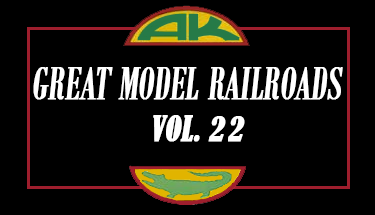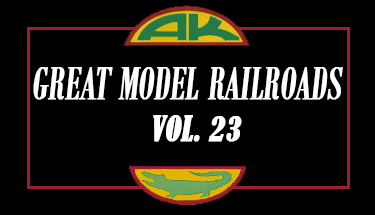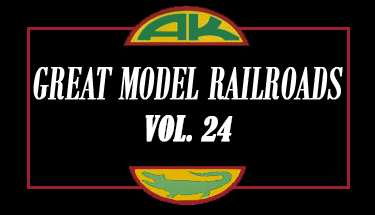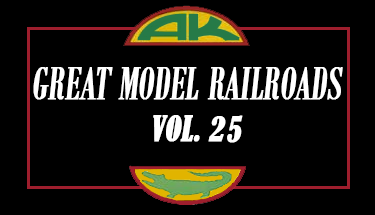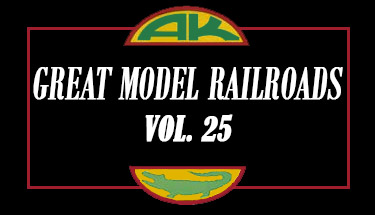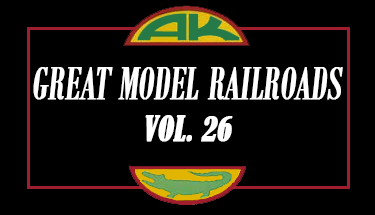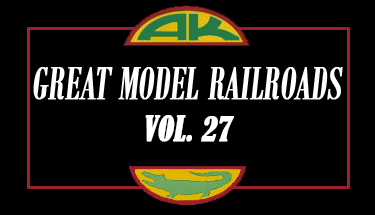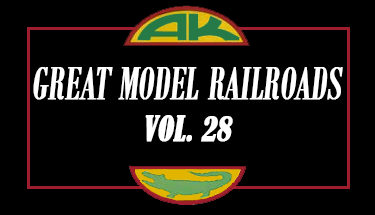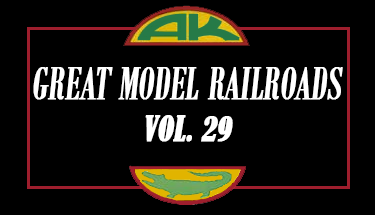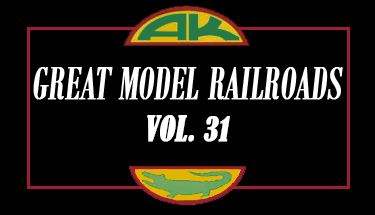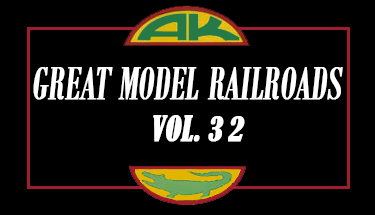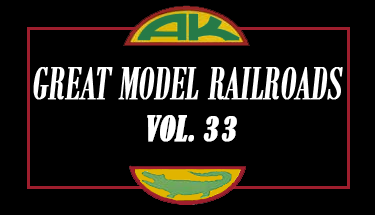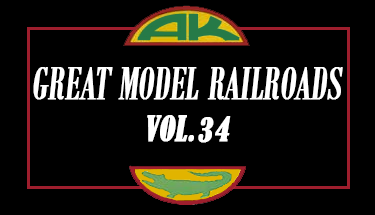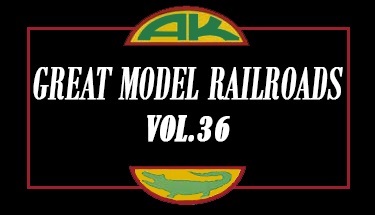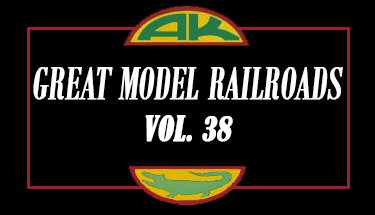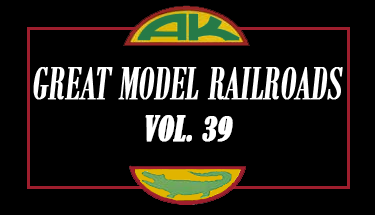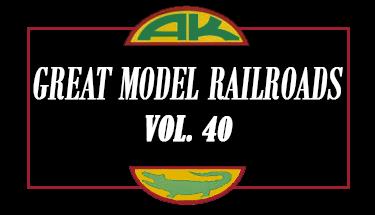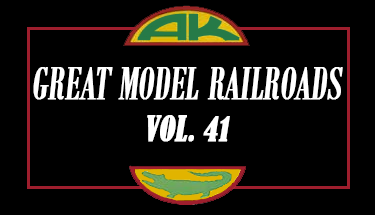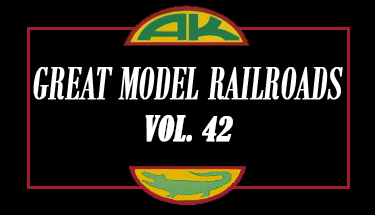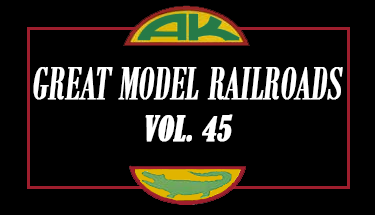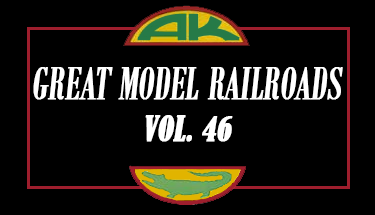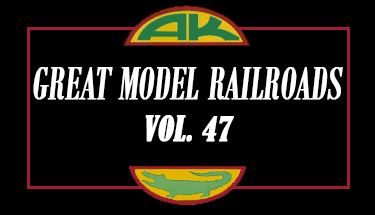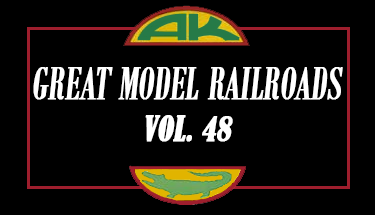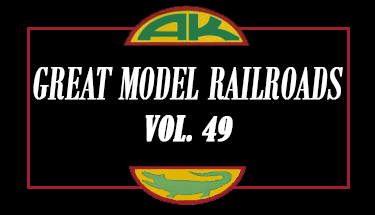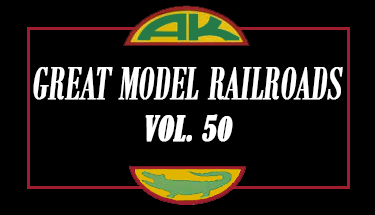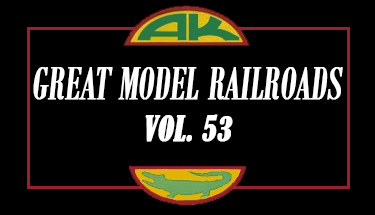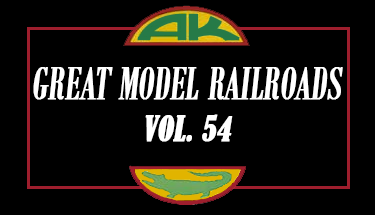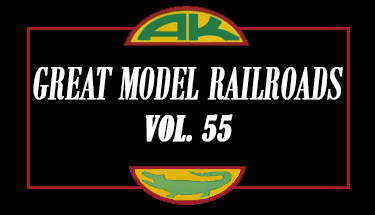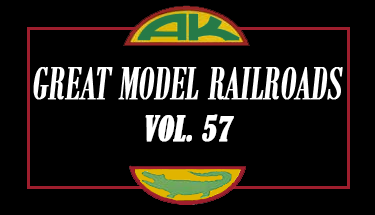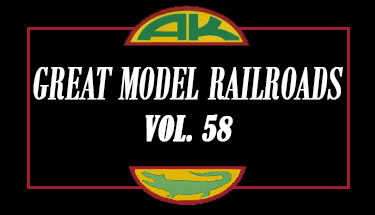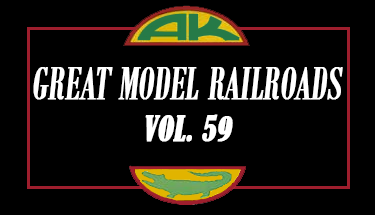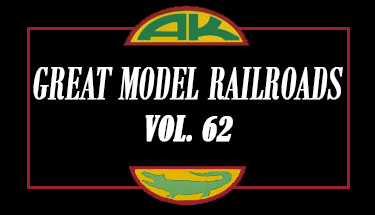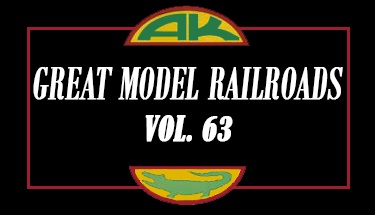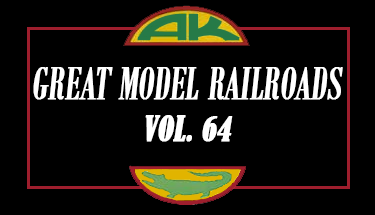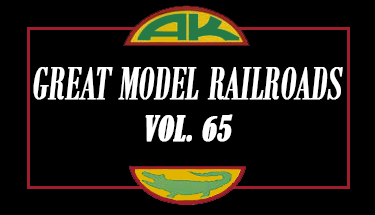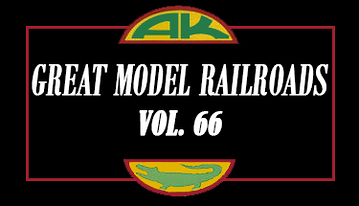Follow along as industry pioneer Allen Keller takes you to some of the greatest railroads around the world! Ride the rails with Allen Keller as he visits some of the best builders and their railroads. Hear from experts as they share their modeling tips and helpful hints with Allen Keller as part of his Great Model Railroads series!
-
Vol. 02: Franklin & South Manchester - Part 1
The Franklin & South Manchester, one of the greatest model railroads ever built, is the creation of professional model builder George Sellios. Because of George's talents you'll see something new each time you watch this fabulous program. You'll tour the layout behind a Mogul powered passenger and a Mountain powered freight, from one end of the 22 x 7 foot layout to the other. Although the F&SM is HO scale, George Sellios, the owner of Fine Scale Miniatures, has created a railroad that exists as surely as Chicago or New York did in the 1930s. See Part 2 here.
-
Vol. 05: Don Cassler's M&K Divison of the B&O
The M&K Division of B&O Railroad is a spectacular model created by Don Cassler and fellow builders, Bill Hanley and Mark Vinski. Don welcomes Allen into his home to unveil the fruits of a 20-year project. The trio’s layout is based on collective memories of cherished train-watching locales, and was specifically designed to suit the space of Don’s basement.
The Baltimore and Ohio Railroad (B&O) is the oldest railway in the United States. Don’s scale model represents the West Virginia portion of this legendary railroad, where towering mountain grades are common and helper engines contribute additional power to inch winding trains of 50 cars up the steep gradients. 20 years of hard work put in by Don, Bill and Mark is without a doubt on full display, and it’s an understatement to call the incredible M&K a true masterpiece.
-
Vol. 06: Dick Elwell's Hoosac Valley Railroad
Dick Elwell's Hoosac Valley is a bridge route that interchanges with the Boston & Albany, the Delaware & Hudson, the New Haven and the New York Central. The HO railroad features magnificent New England scenery with lots of rivers and forested mountains. Dick will show you his method for making super-detailed foreground trees. That skill at detailing carries over to the layout's many mini-scenes. These are life-like vignettes that tell a story of a slower era. You'll be inspired as Dick recounts some of his early pitfalls as a beginner in 1959. And you'll enjoy knowing that this layout evolved from an idea on a piece of paper into a Great Model Railroad.
-
Vol. 07: Harry Clark's Indian Creek Valley Railroad
Harry Clark’s Indian Creek Valley is one of the most incredibly built model railroads you’ll ever see. Nearly everything on the layout is scratch built, including thousands of trees. Harry worked in carpentry for more than 50 years, during which time he developed many unique modeling techniques. The Indian Creek Valley Railroad operates in the mountains of Pennsylvania, and depicts the lumber business of the ‘40s and ‘50s. Harry knows wood well and loved modeling the production chain from forest to mill. As you will quickly learn, the layout scenery bears exceptional detail and Harry continues to strive for more. Come along as we take a tour of Harry’s wooded Pennsylvania paradise!
-
Vol. 08: Granite Mountain Railway
Doug Geiger’s Granite Mountain Railway is a huge layout forced to fit into a tiny space. The room in which the railroad resides is a mere 43 by 23 feet. To deal with this lack of space, Geiger made the tracks of his model run along three tiers. The operation and production of such a massive layout created unique challenges. Luckily, Geiger has two groups of friends who help him with construction and operation.
When observing a layout, viewers look down on it from an outsider’s perspective. But what if they found themselves inside the layout, spectating through the eyes of a passenger inside the trains? That is Doug’s goal—to make his model railroad operations as realistic and prototypical as possible. Join us as we take a ground-level tour of Doug Geiger’s Granite Mountain, then listen in as he and host Allen Keller discuss their favorite aspects of model railroading.
-
Vol. 09: Rick Rideout's L&N Henderson Subdivision
Rick Rideout’s L&N Henderson Subdivision is a 35x70-foot model railroad layout that resides in an awe-inspiring custom-built basement. Rideout scaled down the 146-mile subdivision to an 8-scale mile HO layout. His obsession with the L&N is deeply rooted and so strong that he built his house along a former L&N line.
In his exclusive behind-the-scenes series, Rideout takes us down the tracks of his magnificent L&N subdivision. He explains the impetus for its existence, which stemmed from a lifelong love affair with these stories tracks, and talks in-depth with Allen Keller about his model’s origins, construction and operations. Rideout views modeling railroads as a challenging and rewarding art form that allows him to express himself as well as his rail fandom.
One third of Rideout’s L&N layout is scenic. Its focal point is a spectacularly designed bridge that spans the Ohio River between Evansville, IN and Henderson, KY. The bridge runs 23 feet and rides out to Louisville and Nashville. Rideout utilizes mass-produced items that cannot be found in stores, in addition to advanced electronics controlled by computer software, which handle the centralized traffic control machine and signals. Rick Rideout’s ambitious scale model of the L&N Henderson Subdivision is truly a wonder to behold, and Allen was thrilled to get a backstage look. Join him, won’t you?
-
Vol. 10: The N Scale Cumberland Valley System
The Cumberland Valley System of Bill and Wayne Reid is undoubtedly the most famous N scale layout ever built. The Reid brothers have taken a 22X40 foot area and built a railroad that not only looks fabulous but runs with the reliability of the larger scales. You'll learn some of their methods for obtaining this level of performance. Bill and Wayne have designed the layout so the scenery dominates the trains thus creating a feeling of distance. They'll show you tips for tracklaying, rock carving, and kitbashing structures.
-
Vol. 11: Allen McClelland's Virginian & Ohio
Take a ride with us along the rails of Allen McClelland’s famous HO scale Virginian and Ohio. The Virginian and Ohio, or V&O for short, has taken on a lore among modelers as a prototype to be emulated, and is oft referred to as the complete model railroad. Every minute detail on McClelland’s spectacular layout contributes to the whole, and each of its impressive features stands out without overshadowing the others. The coal haul and bridge route of the V&O spans a 32x32 foot space of open-grid benchwork and hand-laid track.
McClelland is renowned for pushing the boundaries of modeling, and he’s responsible for many innovative approaches utilized throughout the industry. For McClelland, prototypes can provide a solution to all modeling problems. As he tells Allen Keller, the V&O’s name combines McClelland’s home state of Ohio and his railfanning mecca in West Virginia and Virginia. Come along as we take a closer look at all that makes the V&O a masterpiece!
-
Vol. 12: The Piermont Division of the Western Maryland
This is Howard Zane’s HO scale model railroad layout, a masterpiece that features the 1955 Western Maryland railroad. His Piermont Division is considered a great artistic achievement in the modeling community. The colors, textures, scenery, and structures were all artfully and methodically placed and with incredible detail. Zane has a background in sculpting, designing and painting, which has helped him in his modeling. He is also a partner of the Great Scale Train Show. To him, the Piermont Division of the Western Maryland has meant hours of modeling fun and the ability to create a window into a period of history in which Zane wishes he could be. It's his dream to be in the 1950s on a porch, playing banjo, and watching the trains go by on the Western Maryland.
-
Vol. 13: Gil Freitag's Stony Creek & Western
The Stony Creek & Western is the work of master structure builder, Gil Freitag. Gil has won many, many NMRA National Contests for his scratch-built creations, and you'll learn some of his successful techniques. His Santa Fe and Denver & Rio Grande Western trains operate over and through beautifully colored Colorado scenery. Gil will show you how to build your own electro-magnetic uncoupling ramps, and how to make scenic landforms using sand instead of plaster.
-
Vol. 14: Allegheny Midland Railroad
Join us as we take a trip through the high mountain rails of West Virginia to explore Tony Koester’s unique model of Allegheny Midland Railroad. Tony’s scale model still stands as one of the most ambitious model railroads the world has ever seen. Follow along and learn about methods of modifying common plastic kits into one-of-a-kind structures and much more!
-
Vol. 15: The Yosemite Valley
The Yosemite Valley of Jack Burgess is as close as you can get to having a time machine that will transport you back to August of 1939. Jack is a stickler for historical accuracy not only as it relates to railroad equipment, but to life in general. Everything on this multi-level HO layout--the signs, the structures, the people and the automobiles--is stamped with authenticity. With this detailed knowledge, his structures and rolling stock are scratchbuilt to exact dimensions. The YV duplicates the passenger, logging and mining operations that made the railroad possible. The California Golden Hills are Jack's specialty and he'll show you how he gets the right look for his scenery. The Yosemite Valley is a Great Model Railroad because of Jack's unswerving devotion to accuracy and high modeling standards.
-
Vol. 16: Bob Brown’s Tuolumne Forks
In this series you’ll get an in-depth tour of master modeler Bob Brown’s Tuolumne Forks Model Railroad. Tuolumne Forks is an O&3 freelanced narrow gauge logging and mining railroad. The layout combines mining and logging with a tourist line, and the operation follows the Lake Tahoe Railway and Navigation Company’s transport of tourists from Workshop to the Lake Tahoe Resort. Both of these locations fit into a 19x25-ft area to form a railroad that’s famous among narrow gauge enthusiasts. When he isn’t narrow gauge modeling, Brown is the editor and publisher of the Narrow Gauge and Shortline Gazette. Brown and the magazine have created a fellowship of fine narrow gauge modelers from around the world. Brown has devoted his life to narrow gauge modeling because he finds almost every aspect appealing, including creating the look of rundown equipment with a homemade touch. Brown started work on the Tuolumne Forks model railroad in 1981, and has continued to model for more than fifty years.
-
Vol. 17: Cat Mountain & Santa Fe
David Barrow's Cat Mountain & Santa Fe represents the embodiment of 25 years of planning and designing the ultimate linear walk-around trackplan. The HO scale Cat Mountain gives operators the feeling of actually traveling with their trains because the construction of the room and layout block everything but only a small part of the railroad at a time. The CM&SF is a Great Model Railroad because David's expertise as an architect has given him the freedom to incessantly refine his ideas of the perfect railroad trackplan.
-
Vol. 18: Harold Werthwein's Erie Railroad
As a young man, Harold rode the Erie Railroad, watched it, and loved it. This affection for one railroad evolved into a lifetime of study and exploration. Then he modeled the Delaware Division between Port Jervis and Binghamton, New York in HO scale. This series of videos is a tribute to Harold and his impressive work. Harold Werthwein was an armchair modeler who got serious about building -- very serious! The Delaware Division could handle over 40 trains during an operating session. Harold captured the feel of the Erie on this large layout due to careful attention to the scenery of southern New York and northeastern Pennsylvania, including probably the most famous railroad bridge of all, the Starrucca Viaduct. The HO-scale Erie Railroad fills Harold’s 85x30-foot basement. The benchwork is open grid. Most of the visible track is hand laid. Our trip begins in the hidden staging yard for Elmira, New York.
-
Vol. 19: Coal Belt Railroad
Bill Henderson’s HO scale Coal Belt Railroad is a freelance version of several eastern railroads such as the Redding and the Delaware and Hudson. It features many lifelike camelback locomotives, which are known for having their cabs over the boilers so a larger firebox can be used.
Bill is a longtime railfan and student of railroad history, and often quotes classic model railroading masters such as Paul Larson, John Page, and Frank Ellison. To pay tribute to these and other masters, Bill names passenger cars and towns in their honor.
Bill uses very few commercial products to make his inexpensive, natural and impressible inventive scenery. The Coal Belt, which spans 8x20 feet of a storage building at Bill’s Alabama home, represents eastern Pennsylvania in 1910. Ride the rails with us as we go behind the scenes of Bill Henderson’s remarkable creation!
-
Vol. 20: Brandywine & Benedictine Railroad
Norm Stenzel’s Brandywine & Benedictine Railroad is a freelance railroad that exhibits the history of this magnificent line from its maiden coal tows in 1898 to its heyday in the mid-1950s.
The B&B hauls coal through Virginia and West Virginia along an exquisite route made possible by Norm’s careful study of topography. This is a railroad that, if we didn’t know better, could have actually existed. Norm paid special attention to incorporating era-appropriate scenery, and the time and place are impeccably depicted. It’s the perfect blend of operation, scenery, and detail - nothing stands out to detract attention from the trains.
Nicknamed the Mason Dixon Line, the B&B runs north and south from Winston Salem, NC to Pittsburgh, PA. It’s a mountain railroad with a maximum grade of 2.7%, which means she requires helpers to make it out of Salem, VA!
-
Vol. 21: Ron Kuykendall's Five Great Model Railroads
Ron Kyukendall is a master modeler and the proud operator of five incredible model railroad layouts. In this series, Ron introduces us to each of the great railroads that have demanded decades of his commitment to the craft. Three of his layouts are HO standard gauge, one is HON3 and the fifth is SN3.
Ron has managed to accomplish so much on so many layouts after nearly six decades in the hobby, and he’s never afraid to test out new approaches to modeling. Two of his railroads are quite large, while the other three are small diorama types. Because each railroad is shelved, there’s space for them all in his layout room.
Ron loves to prototype exact rolling stock, structures and locomotives. His extensive rail fan photo collection allows him to model precisely, as to him model building is the glue that holds the hobby together. His kits are built from his pictures and drawings without any reference to instructions. He calls this his favorite part of the hobby!
-
Vol. 22: Roger Russell's 3 Narrow Gauge Railroads
Modeler Roger Russell does narrow gauge modeling in a big way, the proud owner of three masterful layouts in different scales: the SN-3 Denver Rio Grande and Southern, the ON-3 Colorado and Southern, and the 3/8th-inch scale Russell Creek Lumber Company. His early exposure to Colorado narrow gauge influenced his modeling, and has helped him win best of show awards and countless first place prizes over the years.
Roger builds quickly, and believes in combining scales for the right look. The SN-3 Denver Rio Grande and Southern, which was the first of his three layouts, is also his favorite due to fond memories of breathtaking Colorado scenery. The 12x28 SN-3 layout features equipment from the merging of the D&RG West and the Rio Grande Southern in the 30s and 40s.
In the room next door we’ll discover the ON-3 Colorado and Southern, which is another 12x28 master class in narrow gauge modeling. Roger’s ON-3 operates between Durango and Ridgeway Colorado. Every component, including more than 2,500 trees, is either kitbashed or scratch-built. The tour of the DRG&S starts in Ridgeway where the west and southern Rio Grande interchange.
-
Vol. 23: Lou Sassi's Western Hoosic Division
Lou Sassi’s Western Hoosic Division model railroad, which runs between Adam’s, MA and Bennington, VT, is an imaginary mine that Lou invented and is operated by the Austin and Maine with an interchange for the runner.
Lou’s 25x22 HO layout features some of the most remarkable scenery you’ll see anywhere in the world. Lou and a circle of friends called the Tree Group have specialized in making trees and ground cover, and in the process they’ve developed revolutionary and effective techniques that advanced the art of scene building for model railroaders everywhere.
Lou is a lifelong New Englander with a special fondness for the area. 20 years in the making, this spectacular division is a unique and breathtaking homage. It was modeled after 1950s New England because he grew up in that time and area, and always enjoyed the small towns with their rolling hills.
-
Vol. 24: George Sellios' Franklin & South Manchester - Part 2
Host Allen Keller visits the fabulous Franklin & South Manchester Railroad of George Sellios for a second time. Now, George has more than doubled the size of the layout with the addition of Dovertown and Bedford Falls. See the major advancements in this Part 2 Series. Join us, won’t you! See Part 1 here.
-
Vol. 25: New England, Berkshire & Western
This series holds a special place in Allen’s heart, made in tribute to the Rensselaer Model Railroad Society on the club’s 50th anniversary and the 25th anniversary of the New England, Berkshire & Western model railroad. This is the fourth iteration of the remarkable HO layout, built by students and friends.
John Nehrich has been a part of Rensselaer since 1968, and always had a dream to build a model true to the original concept, although the layout has been refined over the years.
The NEB&W is in the basement of this hall at the Rensselaer Polytechnic Institute in Troy, New York. Some aspects have changed dramatically since Allen first saw it in 1987, with most of the layout being rebuilt at least twice. But the continuity of the Rensselaer and the layout has remained if not improved.
Each of the club’s 40 members is almost required to be a stickler for accuracy of rolling stock, structures, and scenery, so you’re guaranteed to enjoy the precision of this HO layout. The layout itself is L-girder with hand-laid track and a minimum radius of 48 inches. Allen’s visit to the NEB&W will include a number of trains, so you’ll get a comprehensive feel for the railroad and its traffic. Enjoy the journey!
-
Vol. 25: The Rensselaer Model
This 10-part series with Allen Kelle highlights The New England Berkshire & Western Railroad. The series celebrates the accomplishments of the Rensselaer Model Railroad Society. Allen Keller begins the series right outside Davidson Hall where the magic happens. Although the layout has endured many changes, the layout has remained located in the basement of the same building.
-
Vol. 26: Carrabasset & Dead River Railway
Follow along as we adventure through the rails of Bob Hayden’s Carrabasset and Dead River Railway. In this series, you will learn how to rejuvenate scenery, use building mock-ups for planning, weather with chalk and much more while getting a close-up look at Bob’s master craftsmanship and scenery techniques.
-
Vol. 27: Utah Colorado Western
Lee Nicholas' Utah Colorado Western is a bridge route running from Denver to Salt Lake City in the 1960s. This HO scale railroad features fine running first generation diesels and gorgeous rocky mountain scenery with hand painted backdrops. This creates the feeling the UCW has real work to do.
Both Lee and the UCW are famous for operation. Lee is one of the co-founders of the operation group, Pro-Rail. Because of that interest in operation every locomotive and car must run extremely well or be replaced. Lee wants nothing on the layout that is not up to his high standards. The UCW is a Great Model Railroad because Lee and his friends have used their talents and ideas to continually improve everything on the layout. -
Vol. 28: The Canandaigua Southern
The Canandaigua Southern model railroad is a masterpiece by one of our hobby’s most prestigious riders, railfans, and modelers. John Armstrong is the layout’s president, the hobby’s premiere track planner, as well as the creator of countless ideas and important inventions that we take for granted. His O scale Canandaigua Southern has inspired modelers everywhere to take the plunge on their first layout.
First breaking ground in 1950, the Canandaigua Southern has been under construction in some way or another ever since. Each of John’s remarkable structures is highly detailed and captivating, and his large scratch built locomotives are something to behold.
The Canandaigua Southern is a 1960’s regional carrier with a lot of bridge traffic, and a point-to-point route that fills a 24x34-foot wood base. Both ends, Canandaigua and Pittsburgh, are represented by hidden loops in the center of the room; the top layered curve is actually a reverted loop!
-
Vol. 29: Argentine Division of the Santa Fe Railway
The elements of bustling industrial railroads combined with the urban American scenery of the 1950s were captured to create Chuck Hitchcock’s Argentine Division of Atchison, Topeka & Santa Fe Railway. In this series, Chuck will tell you all about urban modeling, passenger train operation and much more! Follow along and learn why the Argentine Division is a railfan’s dream.
-
Vol. 30: Monroe Stewart's Hooch Junction
Welcome to Monroe Stewart’s gorgeous Hooch Junction, an N scale model railroad featuring CSX and Norfolk Southern trains. Although the layout has about 2,000 feet of track, its scenery is not crowded, utilizing space remarkably. Hooch Junction is set in present day, with urban renewal ever apparent throughout this spectacular layout.
Monroe is a master model railroader who has built six outstanding layouts. The Hooch Junction is his second N scale effort, around which he designed his house. He now redesigns the layout to fit with his interests of trains and boats, with a focus on the relationship between shipping and railroads inspired in Monroe by going to school in Hampton, Virginia, in the Tidewater area.
The Hooch Junction fills a 20x40-foot space, with a minimum radius of 15 inches and a ruling grade of 2.5%. The Hooch Junction contains two separate main lines—Norfolk and Western (now Norfolk Southern) in gray and the CSX in yellow. During this series, we will follow two trains down the tracks, beginning with the Norfolk Southern at the Hooch Junction Engine Facility.
-
Vol. 31: Grosser's Nostalgia Trip By Ray & Renee Grosser
Allen Keller has videotaped literally hundreds of layouts over the last three decades with all kinds of model train lighting techniques, but never before has he ever been able to shoot one in natural sunlight just like the prototypes! Join him as he visits Ray and Renee Grosser’s “Nostalgia Trip” HO layout that recreates the Minneapolis, St. Paul and Sault Sainte Marie railroad , better known by its monicker - the Soo Line. Usually stored away in a convention hall and only appearing only at train shows, Allen persuaded the Grossers’ to allow him to shoot in brilliant sunshine, adding to the cinematic realism that most layouts aim for but can never achieve.
-
Vol. 32: The Model Railroad Club of Union, NJ
The Model Railroad Club of Union, New Jersey traces its origins to 1949, in the basement of Paul Malorey’s home, where the Hudson Delaware & Ohio ran for 23 years. Paul is a hobby pioneer who’s written numerous model railroad books and more than 300 modeling articles. The design of the Club’s layout has remained faithful to Paul’s original concept, with its non-linear track plan and heavy emphasis on operation. The Club gathers for operating sessions each Tuesday evening.
In this series, Allen meets with Scott Dunlap, the Vice President of the Model Railroad Club, on the anniversary of the 50th anniversary of the club. Scott says they’d been planning to triple the size of the layout, with the goal of expanding even further beyond that. The Club’s building contains an office, workshop, and a new N scale layout. The HO layout occupies an area of 40x40 feet. We start the tour in Gilberton, following the trains of the HD&O, the Trenton Northern Electric, and the Rahway River Railroad.
-
Vol. 33: The Denver, Front Range and Western
In this series we take an in-depth tour of Doug Tagsold’s HO scale Denver, Front Range & Western. The DFR&W model railroad layout features trains from the Rio Grande, Sante Fe, and the Burlington Northern, and is set in the spectacular scenery of the Colorado Rockies, where Doug fell in love with big-time mountain railroading.
Doug was so inspired by the rails in the Rockies that when he got home from his trip, he tore down his old layout and started on this double decker. The line duplicates the Rio Grande Main from Denver to Grand Junction, and the Rio Grande and Santa Fe joint line from Denver to Pueblo. Allen Keller calls this layout one of the most dramatic models he’s ever filmed.
Doug’s goal with this layout was to try to recapture the drama he witnessed when he saw Rio Grande trains running through the front range of the Rocky Mountains. The layout’s double-deck spans only only 25 by 40 feet of Doug’s basement.
-
Vol. 34: Gary Hoover's Missouri, Kansas & Quincy
In our latest backstage tour, Allen Keller joins master modeler Gary Hoover to view his layout of the Missouri, Kansas and Quincy. Hoover is a longtime railfan, so he wanted to build an HO scale model railroad that’s as fun to operate and photograph as it is to view in full size.
Hoover’s dream to create the ultimate railfanning experience has made the Missouri, Kansas and Quincy one of the most photogenic layouts Allen has ever seen. It’s clear that Hoover’s skills have continued to improve since he first started his layout in 1985. This modern HO railroad runs from the Chicago area to California, consisting of the Northern and Central divisions. This vast span covers an array of scenes, including standalone modules. Motive power from the Burlington Northern Santa Fe, which has taken over the MK&Q, plus Rio Grande and a few Southern Pacific units can be seen on the layout.
Hoover’s layout takes up almost every inch of his 24x64 foot basement. Its minimum radius is 30 inches. The track is code 100. All visible turnouts are manually operated, and the layout has staging yards hidden under Sedalia and Castle Gate. We’ll begin our operations outside of Chicago at Oak Grove.
-
Vol. 35: Jim Providenza's Santa Cruz Northern
Jim Providenza's HO scale Santa Cruz Northern model railroad is an operation-oriented layout set in the early 1970s. Jim made this double decker so he could railfan his favorite spots in California. The Santa Cruz Northern is a bankrupt, down-on-its-luck carrier owned by the Santa Fe and the Western Pacific.
This model becomes a real railroad set in an actual time period with all of the economic and political facts of life. The Santa Cruz Northern runs through the Santa Cruz Mountains to the Pacific Ocean on a route laid out by the former South Pacific Coast railroad. Why is operation so important to Jim? Most importantly, it gives him a chance to be with his friends and work closely with something he has carefully created.
The Santa Cruz Northern shares a space with the family vehicle, its double-deck setup occupying about 18x22 feet of the Providenzas' two-car garage. Allen's behind-the-scenes tour of the Santa Cruz Northern begins on the lower level at San Jose, California.
-
Vol. 36: John Gray's Union Pacific Cheyenne Division
John Gray’s Union Pacific Cheyenne Division model railroad captures the vast, open spaces of Wyoming. His HO layout was designed to showcase the immensity of America’s West with broad curves and scenic sweeping vistas. The Union Pacific is a great place for John to display his huge collection of brass locomotives and cars. He believes it’s important to get them out of the box and run them both for his enjoyment and the history they impart to others.
Although John Gray is a railroad executive, he shuns the modern scene in favor of the late 1930s through the early 1960s. A variety of operating equipment can be seen on the layout, which is to John’s liking. He sees the layout as a way to recreate historical scenes and activities that he saw or wishes he had seen.
In this series, Allen Keller interviews the man behind the Union Pacific. John explains to Allen what makes his layout unflinchingly true to the West and how modelers look at most major lines. The Union Pacific is housed in its own 46x26-foot building, with a minimum radius of 34 inches and a spine roadbed. The UP is a double loop with a lower and upper line, and begins and ends on the only town on the layout, Cheyenne, Wyoming.
-
Vol. 37: Western Pennsylvania Model Railroad Museum
The Western Pennsylvania Model Railroad Museum is set in the early 50s, where steam, steel and stamina powered the economy. The people around Pittsburgh and Cumberland, MD are hard at work rebuilding post-war prosperity. Soon the country will revel in the Eisenhower years, and it’s a good time to be American.
This magnificent museum captures that important time and place in its vast historical HO diorama-style layout. It’s been here since 1948, but now the members have their own permanent home to showcase this massive educational project. Two railroads feature in the 10 square miles between Pittsburgh and Cumberland—Baltimore & Ohio and the Mon Valley run parallel throughout most of the layout.
Allen Keller joins Ray Mueser, President of the Western Pennsylvania Model Railroad Museum to learn about its mission and its guiding principle: to showcase this country’s historic areas when trains ruled the land. We make our behind the scenes from Pittsburgh to Cumberland, starting in the great Steel City.
-
Vol. 38: Bluff City Southern Part 1
Allen Keller’s Bluff City Southern is set in the area around Memphis of 1950 when cotton was king. He models 5 railroads- Illinois Central, Frisco, L&N, Missouri Pacific and Southern-that helped make the city a major distribution center for the Mid-South. The HO scale BCS is filled with deep scenes that are highly detailed. Allen tries to embellish the interesting qualities of a scene while de-emphasizing the dull parts. The railroad and its scenes are a way for Allen to re-capture his childhood in Memphis of the 1950s. He’s captured the look of hot, vast fields, slower paced rural living, poor but proud sharecroppers, and magnificent mansions of the antebellum South.
-
Vol. 39: George Sellios' Franklin & South Manchester - Part 3
George Sellios is the creator of the legendary HO scale layout of the Franklin & South Manchester Railroad set in 1935. George began construction on the layout in back in 1984. His model is now considered to be the most highly detailed layout ever built. Since the beginning of construction, many changes have been made to the layout. Allen and George take a look at the newly completed areas of the layout.
-
Vol. 40: The New York, New Haven and Hartford
Bill Aldrige’s HO-scale New York, New Haven and Hartford model railroad is the result of exhaustive research and outstanding scratch building. Bill fell in love with the real New Haven as a kid, and his devotion continued through his working years as a member of the railroad’s Board of Directors. So it was only natural that the layout with authentic details in his basement would become a museum for his memories of majestic days past, and a place for Bill to house and display his enormous fleet of scratch-built steam engines and passenger cars.
The NYNH&H layout runs a loop around the edge of Bill’s 50x75-foot basement, designed just so because Bill’s main goal with the layout was reproducing scenes along his beloved New Haven shoreline. He completed it in only three years after the original version was torn down after 20 years. The minimum radius is 50 inches with flex track, and the benchwork is made of 2x4s bolted to the walls. Join us for an in-depth tour around the layout as we begin to make our way out of Providence, Rhode Island.
-
Vol. 41: Florida East Coast Key West Extension
The Florida East Coast and its Key West extension were facing bankruptcy as the depression spread. In January 1930, the road was enjoying just enough tourist attraction and freight traffic to and from Cuba to remain in the black. This HO scale recreation of the FEC was built for Cal Winter by Railserves’ Ross and Gail Allen as homage to that difficult but proud time in rail history.
The railroad starts in the Everglades, in the southernmost place where fresh water flowed in the Northern Glades. Cars would load up with water daily and head south, where another train would later pick them up.
This magnificent layout represents the line from Miami to Key West with a staging yard serving as Jacksonville. 33 bridges and lots of water were needed to preserve the memory of the prototype’s engineering marvel. Allen Keller’s wife Janet Keller joins Cal Winter to discuss the railroad, and asks if he’s happy with Railserve’s work. For Cal, it is everything he could have hoped for and much, much more. It is a special layout to him. The tour begins in the upper deck at Key West.
-
Vol. 42: Bruce Carpenter's Burlington Northern Santa Fe
Bruce Carpenter's Burlington Northern Santa Fe is big-time modern railroading on a grand scale. Bruce and his operating crew run up to 50 trains per operating session. In those trains they move between 800 and 900 cars across the railroad. This prototype inspired bridge route allows for maximum traffic density between Chicago and Stronghurst, Illinois. You’ll also learn how to improve the operation of your diesels, add inexpensive details to your locomotives, and weather your engines with an airbrush.
-
Vol. 43: New York, New Haven & Hartford
John Pryke’s New York, New Haven & Hartford model railroad layout follows an important historical line that ran from New York to Boston and is set in 1948. This HO scale railroad features three yards with short running distances between them. Passenger trains play a major role in the operations. Research is part of the fun for John as he works to create the feel of a class 1 operation with heavy running and lots of motive power.
The line boasts many brass steam engines that John has scratch built, one of which is almost 40 years old and still running. Everything on his layout is nicely weathered to reflect the atmosphere of post-war railroads. When Allen asks John why he decided to create the New Haven model railroad, he learns that the New Haven was the first class 1 steam diesel railroad that John remembers. Everything in New York City was electrified at the time, but electric could never compete with the roaring of a steam engine.
The New Haven model railroad is built on L girder benchwork with a minimum radius of 36 inches. All track is hand laid with super elevating curves. This island-style HO layout takes up 20 by 30 feet in John’s basement, and gains running distance with a track plan that doubles back on itself, so scenes that are visibly close may represent scenes that are actually many miles apart. Our tour of the New Haven begins in South Boston.
-
Vol. 45: Bob Lawson's Southern Railway
This HO scale railway in Kentucky is Bob’s vision of small town Appalachia. Bob is an architect, engineer and builder who is known for creating dioramas that tell stories of life in the 1940's and early 50’s. As a child, Bob wrote fan letters to the Southern and finally wound up designing freight cars for the railroad and others. He is so dedicated that he even has a real southern caboose that he plans to restore.
The layout is full of eye catching scenes based on years of observation, notes, and photos. His scratch built structures are some of the best you’ll ever see. Trains run from Somerset to Danville, Kentucky, through scenes that Allen Keller touts can only be called artistic.
Allen Keller is with Bob to touch on the layout’s famous diorama-like construction. Allen Keller asks why he built the layout in the series of dioramas. For Bob, having all the intense detail work in dioramas that are portable and can be moved with him, they are ideal.
Bob’s railway has its own building, a former 3 car garage that is 24 by 30 feet. Most of the railroad is built on styrofoam. The track plan is complex due to the many loops that are used to gain running time. The trip begins and ends at Somerset, Kentucky.
-
Vol. 46: Boston & Maine New Hampshire Division
This is Paul Dolkos’s beautiful Boston and Maine railroad. This HO layout is set in 1952 New Hampshire. Paul has been in the hobby since he was a child and has been taking pictures of trains almost that long. Today he is one of the hobby’s best known model photographers, so his layout scenes are carefully arranged for interesting photos. The railroad is highly detailed but not overly busy. Paul says he likes to keep viewers’ eyes focused on the trains and their operations, a showy picture can destroy the illusion of a real Boston and Maine railroad.
The Boston and Maine railroad is a freelanced layout that is based on a prototype railroad. In this video, Allen Keller discusses why Paul wanted to model New England. For Paul, it offers great diversity, interesting railroads, and wonderful scenery and operations. The Boston and Maine railroad takes up 20 by 20 feet in Paul’s fully finished basement. The minimum radius is 26 inches and the benchwork is L girder and open grid. Insulation foam is used as the base of the layout. The railroad runs from southern staging at South River to northern staging at North Gorham. We will begin our trip through New Hampshire at Woodsriver.
-
Vol. 47: Lance Mindheim's Chicago, Indianapolis and Louisville
The Chicago, Indianapolis and Louisville, commonly called the Monon, is an N scale railroad by Lance Mindheim who is also a custom layout builder. The railroad runs through Monroe County, Indiana and is set in 1955. Online industries are limited, yet Lance and his friends can have full timetable operating sessions that last for up to three hours. Locomotives and cars must stand up to that kind of action, so it requires mechanical dependability with reliable track work and turnouts. Lance says all these conditions are now possible with N scale.
Allen Keller is with Lance to ask why he decided to build the Monon. Lance grew up in the southern Indiana town of Bloomington where the Monon happened to run through. The railroad had a lot of Indiana hometown appeal for him. His layout takes up 40 square-feet of Lance’s basement with two staging yards extending into another room. The benchwork is L grider with spline roadbed and cork. The scenery base is Styrofoam. We will begin our trip from south staging.
-
Vol. 48: Ed Lorence's Baltimore and Ohio L&S Division
Ed Lorence’s Baltimore & Ohio L&S Division is a result of 50 years of trial and error. This HO scale model railroad is the culmination of many lessons learned on previous layouts. This railroad runs from Grafton, West Virginia to Fairport, Ohio, and is based in 1954.
Although it’s freelance, Ed tries to create the feeling of a Class 1 railroad, with flawless track work and rolling stock adjusted into 50-car trains where the semi scale wheels run perfectly. His engines are all reworked and re-geared so they are some of the best runners you will ever see. As such, the B&O is a joy to operate!
Ed decided to model the Baltimore & Ohio L&S Division because it was the first common carrier in the United States. It runs through West Virginia in Ed’s 22x24-foot basement with an extension into the laundry room. The layout is built on L girder and open grid benchwork with a minimum radius of 36 inches. The tour starts at East Elkins, West Virginia.
-
Vol. 49: The Emporia Subdivision of the Santa Fe
The Emporia Subdivision of the Santa Fe model railroad belongs to two of the best-known authors on all things Santa Fe: Stephen and Cynthia Priest. The couple’s railroad runs through Kansas in 1978, a place and time Stephen is very familiar with since he worked in the area as an engineer and later as an executive with the track maintenance department.
The HO Santa Fe layout is freelanced, but based on a prototype Steven knows so well. The purpose of the operating sessions on this railroad is to have fun and socialize with good friends.
Allen joins Stephen to tour the railroad, and asks why he chose to build this particular railroad. Stephen has had the opportunity to work on a number of great railroads in Kansas City, so this is his way of giving back. The Emporia Subdivision of the Santa Fe model railroad occupies 40 by 25 feet on two levels with a minimum radius of 36 inches, and all of the benchwork is removable. The tour begins at the open staging yard at Wellington on the layout’s upper deck.
-
Vol. 50: Chuck Hitchcock's Argentine Industrial District Railway
The Argentine Industrial District Railway is Chuck Hitchcock’s answer to the question, “Is it possible to outgrow a renowned 30-year-old layout?” This former Santa Fe Argentine division was famous for being one of the first layouts operated in a prototype manner, and it was a subject of Great Model Railroads Volume 29. Chuck was especially noted for his work in recreating accurate passenger train operations of the early 1950s, and he’s pioneered innovative ways to enjoy the hobby.
The new installment of this HO railroad began as an idea about a decade before its creation. The Argentine industrial district represents a Santa Fe switching line around Kansas City in 1963. All trains operate under yard limit rules. Chuck wanted to build a layout that would provide opportunities for switching capabilities.
The Argentine Industrial District Railway sits in a 24x26-foot basement that housed the old layout for 30 years. The benchwork runs around the room and is cantilevered from the walls, and the railway switches many Kansas City industries. Let’s take a ride along Chuck’s famous tracks!
-
Vol. 53: Conrail New Jersey Division
The Conrail New Jersey Division is based on lines discovered and explored when Mat Snell was a young railfan. Discover the look and the gritty feel of the areas around Newark, the Northeast Corridor, the chemical plants and the high speed commuter lines. In addition to Conrail you’ll see trains from Amtrak, New Jersey Transit and the Susquehanna, all following the Northeast Operating Rules that the railroads of New Jersey use. The layout is controlled by signals and dispatchers and runs with different schedules for day and night.
-
Vol. 53: Ken McCorry's Conrail
Ken McCorry’s massive Conrail is reported to be the largest home model railroad layout in the world. This was not the original aim for Ken, he just wanted to recreate his favorite part of Pennsylvania in the early 1980s. The Conrail railroad layout follows the route of the old Pennsylvania railroad from Harrisburg, Pennsylvania to Buffalo, New York. It takes a train about 45 minutes to run the full length of this HO railroad. That means the main line is 25 scale miles long.
Allen Keller asks Ken why he built this layout over 1,500 feet long. Ken wanted to be able to run 40 car trains on a long mainline run through many recognizable scenes. The layout seems a bit overwhelming when one first beholds it, with its own 32x80-ft. building and a 24x32-ft. addition, totaling more than 3,300 sq. ft. If this wasn’t large enough, Ken has stacked the layout, so in some places there are five levels. The highest and lowest levels serve as his staging and most of the visible action is on levels three and four.
-
Vol. 54: Gary Hoover's Santa Fe Railroad
Gary Hoover’s former layout, the Missouri, Kansas and Quincy, was a beautifully done work of art that ran from Chicago to Los Angeles and set in the present day. His new Santa Fe model railroad is set in the steam-to-diesel transition period and runs from Chicago to Los Angeles staging. Gary used photos to create exact scenes, as building scenery and taking photos of a layout is what he enjoys most. This HO railroad follows the Santa Fe rules and operating practices and was designed as a rail fanning experience with deep scenes and walk-around controls.
Allen Keller joins Gary Hoover to discuss how the current layout compares to his previous Missouri, Kansas and Quincy model railroad. Steam and first-generation diesel rules the new layout and is based in August 1951. The almost finished layout fills the basement of his home with a minimum radius of 30 inches, and the benchwork is plywood and two-by-fours. The model portion of the Santa Fe runs from San Bernardino, California to Chicago. Staging yards serve both ends of the layout. The tour of the layout starts in Chicago at the Dearborn Station.
-
Vol. 55: Jerry Macri's Pennsylvania
Jerry Macri’s Pennsylvania railroad might be the largest home layout ever built. He began building the layout in his 2,800 square-foot basement, which he added onto 9 years later to develop it into the 4,300 square feet it is now. It takes a train about 25 minutes to run from one end of the layout to the other. Everything on this HO layout is huge, including the famous Horseshoe Curve at 30 by 12 feet and the massive Erie Ironworks at about 40 feet long.
The railroad is only half completed because Jerry is in no hurry to finish it; he enjoys it too much! He decided to model the Pennsylvania when he went to the Horseshoe Curve with his wife on vacation, and fell in love with it. With a layout this big, the towns are far enough apart so a train is never in two towns at once. Along the route, trains travel through scenes that are up to 5 feet deep. The layout runs from Chicago Staging to New York Staging, with the tour starting in Ironton.
-
Vol. 56: Cliff Powers's Mississippi, Alabama & Gulf
This is the gorgeous Mississippi, Alabama and Gulf model railroad by Cliff Powers. It's an HO scale railroad with 2 decks currently and eventually three when complete. The model proportion of the railroad runs from Meridian, Mississippi, to New Orleans, Louisiana in 1955. The scenery on this layout is simply stunning, with the use of trees and buildings as view blocks.
Cliff has recreated the look and essence of the South in the 50s, full of piney woods, oak trees, dirt roads, and small towns with wooden buildings. This layout has some of the most highly detailed scenes ever built on a model railroad, and photographic backdrops that help create the feeling of great distances in just two feet of space.
Allen Keller joins Cliff to discuss his railroad, which has its own building and consists of two decks with staging on the bottom and the Mississippi section above. When the top deck is completed, the railroad will enter New Orleans from a double track helix. The helix allows trains to travel from staging to the planned upper deck without entering the Mississippi scene. The minimum radius is 27 inches and the track is code 83 on L girder benchwork. The visit starts at Slidell, Louisiana.
-
Vol. 57: Jim Hertzog's Reading
Watch as Allen Keller and Jim Hertzog explore the Reading Railroad in this 11-part video series. This series takes you on a behind the scenes tour of the Reading layout and an inside look at the operations. Jim also demonstrates several step-by-step tutorials on scenery and weathering. So be sure to follow along for model railroading inspiration and techniques to improve your own layout.
-
Vol. 58: Howard Zane's Piermont Division
Built by Howard Zane, the Piermont Division is one of the most artistic layouts in our hobby. Of course it is – it’s straight from the mind of a graduate of the famous Parsons School of Design! Howard has worked professionally as a painter, sculptor, and industrial designer, and that training and talent are apparent everywhere on his masterful layout. This dazzling HO railroad winds through the coal mine country of 1950s Appalachia.
The Piermont leases equipment for many eastern roads because Howard can’t limit himself to a favorite prototype. Since retiring in 1987, Howard has devoted much of his time to building and rebuilding this layout. In fact, his basement has been expanded twice already to handle this massive railroad!
Allen Keller joins Howard in his basement layout room to discuss the railroad and all that goes into it. Howard has been an artist for many years, but to him model railroading is the ultimate artform, and nothing has been as challenging.
-
Vol. 59: Bluff City Southern Part 2
Allen Keller’s remarkable Bluff City Southern model railroad features five railroads. Since releasing the overview of his first installment in 2001, he has completed the Tennessee Peninsula. Now the layout consists of three peninsulas including Bluff City Yard in Memphis, which is the main classification yard.
Each peninsula is controlled by a different railroad; in Mississippi it’s the Illinois Central, in Arkansas it’s the Frisco, and in Tennessee it’s the Southern. The Missouri Pacific and the Louisville and Nashville have trackage rights on some of the lines. The colors of the ballast and the company-owned buildings in each peninsula are appropriate for each railroad.
The Bluff City Southern completely fills Allen’s 30x44-foot basement. It’s built on two-inch Styrofoam panels, each with a minimum radius of 34 inches. Each of the three peninsulas operates like its own division, although all interchange in Memphis. The tour of the railroad will begin at Jackson, Tennessee, where an IC passenger train comes from the Chattanooga and Points North staging yard.
-
Vol. 60: Allen McClelland's Virginian & Ohio, Gauley Subdivision
On March 16th 2008, a landmark model railroad had its final public showing. On this day Allen McClelland had his last open house for his world-famous Virginian and Ohio, Gauley Subdivision model railroad. Due to physical limitations, Allen had to move to a retirement home. About 200 Virginian and Ohio fans came to pay tribute to this legendary modeler and his railroad.
This installation of Allen Keller’s Great Model Railroads series will be different from most, since this railroad is not yet finished. However, this is an exception to the rule, as Allen McClelland is such an icon to the hobby.
-
Vol. 62: Seneca Valley Lines
The Rochester Model Railroad Club recreates the Lehigh Valley railroad of the 60s, but the club's HO layout is called the Seneca Valley Lines. This 70 year-old-club has been in business in the basement of a 150-year-old church for more than 20 years. The layout is divided into five sections with a supervisor in charge of each, which maintains quality control and a vision for meetings.
Allen joins Tom Mccolloch, president of the Rochester Model Railroad Club, to talk about its fantastic model railroad. The club models the Lehigh Valley railroad from Jersey City, New Jersey, to Buffalo, New York. The HO line is 40 by 60 feet, and the minimum radius is 36 inches on open grid benchwork. The railroad is a freestanding island design, and all trains start and end in the massive staging yard.
-
Vol. 63: Mike Burgett's Chesapeake & Ohio
Mike Burgett’s Chesapeake & Ohio runs along the James River Valley in Virginia in 1965. This HO double deck railroad was built with the prototype always as a guide. The layout is a coal hauling line yet it has no coal mines. Mike’s knowledge of the placement and operation of signals has been applied to this layout and has kept the whole system relatively simple yet prototypical. The layout features a 600 foot mainline in a 24x36 foot basement with two decks. It’s based on stories and research that he has gathered from current and retired railroaders and supports his belief that the prototype has the answers for model railroads. The layout is a time machine for Mike and his friends when they run eight to 10 trains during their operating sessions.
-
Vol. 64: Greeley Freight Station Museum Part 1
Greeley Freight Station Museum houses one of the world’s largest HO scale layouts. The Oregon, California & Eastern is the dream of retired newspaper publisher David Trussell. He started building this layout in 2004, and by 2009 95% was complete and open to the public. A group of dedicated volunteers worked 30,000 hours to bring this amazing project to fruition.
The OC&E has vast scenic vistas that showcase the rugged terrain between Klamath Falls and Lakeview Oregon. In addition to OC&E trains, the railroad also runs Southern Pacific, Great Northern & Denver, and Rio Grande locomotives.
In this video series, Allen Keller joins David Trussell to tour the Greeley Freight Station Museum and get some valuable insight on modeling. The OC&E is a fun and highly unique model railroad. The OC&E’s 9,600-square-foot home is a lot bigger than the average basement. Because of its size, and to do the railroad proper justice, this series is divided into two parts. In Part 1, Allen covers the line from Chiloquin Staging to the Quartz Mountain summit.
-
Vol. 65: Greeley Freight Station Museum Part 2
We return to the Greeley Freight Station Museum layout of the Oregon, California and Eastern in the second part of this Allen Keller video series. It takes a train up to an hour and a half to run the entire line from staging yard to staging yard, and requires 24 people to operate. This 5,500 sq-ft layout is the work of a dedicated group of volunteers and the vision of one man: David Trussell.
David Trussell is the designer of the Oregon, California and Eastern. Even David is surprised that this is the first time Allen has ever had to divide a layout into two shows because of the size. The layout began with a construction crew of 37, and ended with 34. There is a running joke that the other three guys are still stuck back in the layout somewhere and they’re still looking for them.
In Part One, we explored the Chiloquin Staging to Summit, and in the second we focus on the area between Summit and Fairport Staging.
-
Vol. 66: Penn Valley Railroad
The Penn Valley Railroad runs from Allentown to Erie, Pennsylvania in 1957 and hauls a lot of coal and auto parts. It interchanges with the New York Central, the Pennsylvania Railroad, the Lehigh Valley Railroad and a branchline called the East Eiser & Rocky Bottom. All of this action is contained in a 36 x 46 foot basement. While this is David's fourth railroad, it represents the fulfillment of the layout he envisioned when he started, and reminds him of his childhood in the 1950s. The automatic block signal system took a full year to install. David started the Penn Valley in 2001 and finished it in 2003 with the help of 6 friends. It's a point to point walk-in style layout that offers operators the feeling of actually traveling.
-
Vol. 67: The Lakeside Lines
Tom Harris’s spectacular Lakeside Lines model railroad runs between Chicago, Illinois and Norfolk, Virginia in 1979. The model portion of this HO scale layout runs through only one Virginia town: North Franklin. For Tom, model railroading is a family affair. Outside the house, Tom’s wife Karen has built her own G scale railroad on the front lawn. Tom's layout consists of a 2.5-mile yard and a 2-mile staging yard. He built this huge yard so he could have full size trains of 80 cars, big curbs and long sidings with no compromise.
